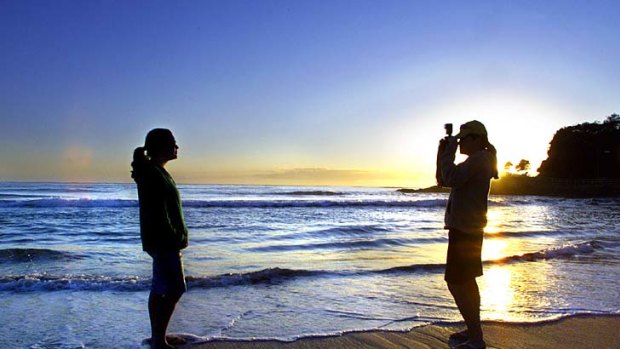This was published 12 years ago
October: the traveller's month from hell

Daylight saving time has dawned again in the southern states.Credit: Robert Pearce
Hundreds of business travellers in Queensland brushed the sleep from their eyes around 3.30am this morning, as they stirred themselves in time to catch the first flights to the southern states – planes that, from October, start leaving around 5am to deliver business travellers to the first meetings of the work week.
People in some offices in Sydney and Melbourne, particularly those in the mining industry, drummed their fingers this morning until around midday – the earliest they could speak to their colleagues in Perth as the two-hour time difference extends to three.
I went out for a social gathering last night around 6pm and marvelled again at the abundance of light in the early evening that we have engineered by changing the clocks.
But some people in the western New South Wales inland are grumbling about kids waiting for morning school buses in the dark and dairy farmers everywhere have to change their milking routines for cows that set their clocks by the sun, not by some human artifice.
It drives the airlines nuts because, like most businesses, they crave certainty. But they’re resigned to the fact that, ever since daylight saving was first prescribed by law in Germany during World War I in 1916 to save on energy in general and coal in particular, the human race has engaged in virtually continuous debate on the merits of changing the clocks twice a year.
But the debate continues. Western Australia, split between the urban population of the southwest and a small rural population spread over an area the size of western Europe, ditched DST in 2009 after a three-year experiment.
Queensland did the same in 1992, but was still arguing about the subject as recently as four months ago when an independent MP, Peter Wellington, tried to have a small area of southeast Queensland between the Sunshine Coast, Ipswich and the Gold Coast, which contains most of the state’s population, excised and allocated Australian eastern daylight time in common with Sydney and Melbourne for six months of the year.
The proposal was voted down by state parliament, but the debate goes on.
Gold Coast Combined Chamber of Commerce president Bob Janssen told the Brisbane Courier-Mail on Saturday it was time for another experiment to get rid of what locals call the annual time warp.
The Gold Coast-Tweed River region is the most schizophrenically affected with a one-hour time difference on either side of the main street in Tweed Heads-Coolangatta.
Janssen said the annual time difference continued to have a negative impact on business and his organisation would keep pushing for a trial. "I think the case for daylight saving is well stated in that we have this disparity in trading hours, particularly with a place like the Gold Coast which sits right on the border," he said.
"The Labor Party is reluctant to do it because it's a nightmare when you are dealing with the northern and western sections of the state and I think the LNP feels the same way.
"I think it's time for another trial run to see how it really does affect people and then we can make some kind of choice in a referendum."
Brisbane-based Virgin Australia, with more flights to, from and within the Sunshine State than any other airline, feels it the most.
“Being a Queensland-based airline operating a national and international network, schedule adjustments to accommodate the implementation of daylight savings is a fact of life for us - as it is for other airlines,” says manager of corporate communications Colin Lippiatt.
“It obviously adds a level of complexity which would not be there if daylight savings did not exist - or if all states moved to it uniformly and consistently.
“This is simply a statement of fact. We are not commenting on the long running debate in Queensland regarding daylight savings.
"There is a set process which is followed each year by our schedules planning team which examines existing schedules, aircraft type deployment and airport curfews.
“We can’t simply just change all Queensland departures and have them operate an hour earlier to maintain the pre-daylight savings schedule.
“Gold Coast Airport has a curfew between 11.00pm and 6.00am. So, we can’t change our current 6am departure to Sydney to a 5am departure. That must stay at 6am local."
But Brisbane departures are generally moved back an hour and that has consequences.
“For departures from Queensland, it would be fair to say we do see a slight drop off in the numbers of passengers booking the first flight of the day for interstate flights,” Lippiatt says.
“Anecdotally, from Brisbane for example, when the first flight of the day moves from 6am to 5am local time we tend to see a preference for the 6am service over the 5am flight.”
The situation is even more complex internationally. For the next month or so, the time difference between Australia, Europe and the US changes by one hour. Then it changes again - but Europe and the US change in different weeks - Europe on the last Sunday in October, the US on the first Sunday in November.
Tell us where you live and how it affects your travels. Do you enjoy arriving in Queensland and WA “an hour earlier” from the south-eastern states? What does it do to your sleep patterns if you regular use the red-eye from Perth? Are you facing major ramifications for international connections you are making in the northern hemisphere in the next month? Are you a supporter of the status quo or should we keep tinkering?
Sign up for the Traveller Deals newsletter
Get exclusive travel deals delivered straight to your inbox. Sign up now.